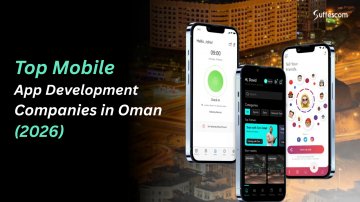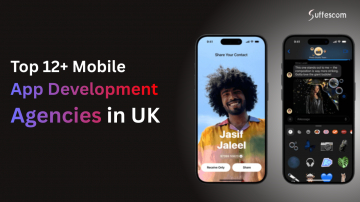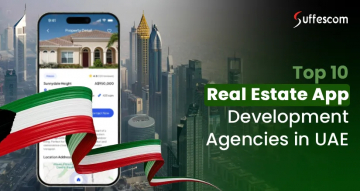How to Develop an App like UPX Browser | Key Features, Cost, and Development Guide

We are in a time where speed and security matter the most for users. This is where the UPX browser has become a reliable choice for people who want secure and unrestricted access. Also, what makes UPX browser unique from other browsers is that the app has a built-in VPN, which allows users to use any app or information without being blocked because of their location restrictions.
This rising requirement for secure browsers also comes with an opportunity for businesses looking to stand out in the UAE market. A custom VPN-based browser builds user trust and increases engagement.
In this blog, we will explore why UPX browser app development is a must-have, what its features are, the costs, and the development approach. So, let's dive in.
What exactly is UPX Browser?
UPX-browser is a type of VPN-integrated web browser that is developed to provide users with safe and secure access. It integrates a proxy service that helps to use the browsers in any restricted location. But the question that comes to people's minds after knowing its functionality is whether it is a safe web browser. While it comes with encrypted access, its legality is dependent on the regulations because misuse of it can result in consequences. So while developing such an app, keep everything in mind.
Understanding Key Features of UPX Browser

The success of an app like UPX browser lies in its features. To develop a UPX browser, it's very important to evaluate its popular features because each feature plays a role in improving user experience and privacy.
Fast and Lightweight Browsing
UPX is designed to offer high-speed browsing without draining system resources. Its optimized structure makes it ideal for both high-end and budget devices. Key functionalities of this feature:
- Utilises rendering engines for faster page loading.
- Keeps memory and CPU usage low for smooth multitasking.
- Incorporates intelligent caching and lazy loading.
- Maintains speed without degrading VPN encryption performance.
Built-in Ad-blocker and Privacy Protection
Blocking ads and trackers helps in increasing the speed of a browser app like UPX but also prevents data collection. These browsers combine with VPN support, making an exceptional private environment. Key functionalities of this feature:
- Filters various pop-ups, banners, and video ads instantly.
- It filters out pop-ups, banners, and videos.
- Block trackers that appear to acquire personal data.
- Has an incognito or private browsing mode.
- Stops cross-site cookie tracking.
- Syncs with VPN tunnel to anonymize browsing activity.
Customizable User Interface
UPX-like browser app allows users to shape their browsing experience while keeping privacy tools easily accessible. The UI is both personal and practical. Key functionalities of this feature:
- Provides multiple themes, including dark and AMOLED modes.
- Let users adjust layout, font sizes, and tab behavior.
- Allows gesture-based navigation for quicker control.
- Includes quick-access toggles for VPN and ad-blocker.
- Keeps the interface lightweight to manage browsing speed.
Data Saving Mode
This feature compresses web content, making browsing affordable and fast even on poor connections. It works seamlessly with VPN traffic to reduce bandwidth. Key functionalities of this feature:
- Compresses images, scripts, and media content.
- Reduces data use within VPN-encrypted sessions.
- Optimizes page load speed on limited networks.
- Ideal for users in developing regions with high data costs.
- Preserves device performance without reducing page quality.
Multi-Tab Browsing and Gestures
Better tab management enhances ease of use. In UPX, every open tab remains covered by active VPN protection. Key functionalities of this feature:
- Opens multiple tabs with minimal memory load.
- Supports background tab freezing to save resources.
- Maintains VPN encryption across all active tabs.
- Allows tab grouping and reordering for better workflow.
High-End Encryption
A browser like UPX guarantees strong security with high-end encryption standards. This aids in protecting user data from hackers and trackers. Key functionalities of this feature:
- Utilises AES-256-bit encryption of all traffic over the web.
- Secures against DNS, IP, and WebRTC leaks.
- Obeys the strict no-logs policy, allowing users to be anonymous.
- Secure HTTPS connections are supported in all sessions.
- Best for handling sensitive or restricted data.
Split Tunneling
Split tunneling allows users to manage which applications or websites can utilise the VPN It helps in maintaining speed and access to the local content. Key functionalities of this feature:
- Let users route specific traffic through the VPN.
- Keeps local services accessible at normal speeds.
- Reduces unnecessary VPN usage and conserves bandwidth.
- Improves performance by avoiding full-tunnel overhead.
- Enables advanced privacy without limiting user access.
Additional Features
UPX adds more convenience tools that enhance functionality without compromising privacy. These features help improve user retention and overall experience.
- Night mode to reduce eye strain in low light.
- Secure download manager with file control.
- Offline reading with encrypted page storage.
- Syncs bookmarks and settings across devices securely.
- Ensures continuity of sessions through VPN-secured cloud.
So, if you are thinking of building one such VPN-based browser, then you need to keep in mind all these features.
Launch Your Own Custom Browser App Today!
Connect with our app development company to get a free project roadmap!
Step-by-Step Guide to Developing a Browser App Like UPX

To create a browser application that includes support for a VPN requires a proper strategy, the use of appropriate technologies, and a design that is user-friendly. In this section, we are going to discuss every stage of development, from strategy to implementation. So let’s start with the first phase of how to develop UPX browser:
1. Market Research and Requirement Analysis
Before going directly into UPX browser app development, you should learn about your users, do an analysis of the available solutions, and work on a clear roadmap. While doing research, keep in mind that users have a lot of expectations in terms of compliance, performance, and trust for a VPN based app. Let’s explore key aspects you should understand in this step.
Identify Your Target Audience
Being familiar with your users contributes to making each design and development choice.
- User demographics: Target the age, geographical location, and familiarity with technology
- Primary needs: Privacy, access to content, quick loading, and little data consumption
Carry out Competitive Analysis
An analysis of competitors reveals both opportunities and challenges for your app.
- Top Browsers: Learn about the features on UPX, Opera Mini, and Brave.
- Features: Check which features you can integrate that make your app distinguishable.
- User Feedback: Study the reviews on app stores and get to know the problems in the UAE.
Ask Yourself
While conducting the research, you can ask yourself a few questions that will help you provide a better perspective.
- Core Offerings: What would your browser be used for? Would it be for VPN usage with high-speed servers? Ultra-lightweight performance?
- User Focus: Cater to a particular audience, such as students, holiday goers, or people in restricted areas
- Experience Edge: High bandwidth, greater server options, or privacy-first architecture, what would be your primary focus?
Established Technical and Business Objectives
Bring your vision to the form of realities that can be measured.
- KPIs of business: Assumption of Users, downloads, active users, retention rate, or subscription revenues.
- Technical Scope: Must have features, VPN protocols, and compatibility with devices.
- Compliance: Follow data privacy regulations (GDPR, CCPA) and local policies on VPNs.
Moving forward, the second step is the correct selection of the tech stack.
2. Choosing the Technology Stack
Choosing the appropriate technologies for UPX browser app development in UAE is crucial for providing speed and security to customers. Moreover, if you are developing a VPN based browser, you need to think about performance and encryption as well because it will directly relate to how smoothly your apps work under real scenarios.
Decide on App Development Framework
Your development framework determines speed, flexibility, and how easily you can access native VPN functions.
- Native App Development: Swift, Kotlin, etc. are employed, and it is an appropriate choice in such situations as when you want to focus on performance and a profound OS level VPN support.
- Cross-platform App Development: Cross-platform technology, such as React Native and Flutter, is used since they share the same code base.
Select a Browser Engine
The engine renders web pages, handles interactions, and affects compatibility with web content.
- Chromium: It is fully compatible, is accepted by most modern browsers, and is frequently updated.
- Gecko (via GeckoView): Powerful and open-source, but more complex to work with while developing the UPX browser app.
- WebView: It is lightweight, quick to implement, and has limited customization and control.
Choose VPN Integration Tools
Your browser’s privacy layer depends on how securely and smoothly the VPN works.
- OpenVPN: Used to develop secure and private connections.
- WireGuard: Faster, contemporary, minimal resource consumption, and link encryption between the devices and networks.
- IKEv2/IPSec: Stable, mobile-friendly connection compatibility, support in both Android and iOS.
For Backend Infrastructure
A solid backend is very important for handling users, VPN servers, and protected data exchanges.
- Authentication: Incorporate safe and secure logins using OAuth2 and token-based sessions.
- VPN Server Management: Utilise host servers on AWS, DigitalOcean, or Vultr with global region support.
- API Layer: It manages VPN toggles, region choice, user preferences, and sync.
Third-Party Integrations
Add external tools that enhance functionality without compromising user privacy.
- Use Ad-blocking Libraries (e.g., uBlock Origin integration).
- Incorporate analytics for crash reporting (ensure VPN traffic isn't logged if claiming privacy).
- Implement encryption Libraries for data storage and DNS queries
- Push Notification Services (optional) for privacy-conscious users.
3. UX/UI Design
For this phase of development, hire mobile app developers to build a minimalistic interface like UPX browser. Focus on a user experience across all devices. A clean UI helps in increasing trust and helps users to easily navigate throughout the app.
Design Wireframes and User Flow
Begin by evaluating how users will connect or interact with the application from launch to close once it is developed.
- Low-Fidelity Wireframes: Create simple screen layouts for tabs, VPN toggle, and onboarding.
- User Journey Mapping: Determine everyday user flows like connecting to VPN, switching tabs, or saving bookmarks.
- Navigation Structure: Keep menus very simple with quick access to core privacy features.
Prioritize Speed and Minimalism
Your app should feel fast, even with encryption running in the background.
- Lightweight UI Elements: Minimal colors, Flat iconography, and tiny layouts.
- One-Tap VPN Control: Put the VPN control main window, not in settings.
- Do not use Feature Overload: Each addition must provide speed, privacy, or usability.
Focus on Privacy-First Design
Your UI must build user trust by making privacy tools visible and usable.
- Transparent Permissions: Explain why and when permissions like location or storage are requested.
- Visible VPN Status: Show connection status and server location clearly at the top or in a status bar.
- Incognito Mode Access: Let users quickly switch to private mode from the home screen.
Make It Customizable
The adaptable features contribute to making the user use the application more.
- Theme Options: Provide light, dark, AMOLED, and system-based themes.
- Font and layout settings: Enabling Scalable Text and layout to be Accessible.
- Gesture Controls: Provide swiping gestures to switch tabs, to backtrack, or to refresh.
4. Backend Development and VPN Integration
For a VPN-based browser like UPX, backend development and VPN integration are at the core of privacy, performance, and user trust. This stage handles everything from server infrastructure to encrypted traffic routing.
A. Build a Strong Server-Side Architecture
- Use Lightweight & Scalable Backend Technologies:
Choose Node.js, Go, or Python (FastAPI/Django) to power your backend. These are efficient for handling concurrent sessions and encrypted communication.
- Cloud Infrastructure:
Host on AWS, DigitalOcean, or Azure with a VPN server in different regions, such as UAE, the US, Europe, and Singapore. Deploy using Kubernetes or Docker in a containerized form.
- Data Security and Authentication:
Use OAuth 2.0 or JWT to provide secure login. Use encryption on all stored data (AES-256 far more, but not against communication) and require SSL/TLS.
- APIs for VPN and Browser Logic:
Build RESTful APIs to manage user profiles, VPN toggles, preferences, region switching, and bookmarks sync.
B. Integrate VPN Protocols
- Embed WireGuard with the adaptable high speed links. Add OpenVPN and IKEv2/IPSec to get the flexibility of selection with devices and networks.
- Install a daemon or service to create VPN tunnels. Each user session should trigger a secure instance with the selected region/IP.
- VPN Connection APIs that provide endpoints to:
-Toggle VPN on/off
-Select a region/server
-Display connection speed and status
C. Ensure DNS Leak Protection and Kill Switch
- Prevent DNS Leaks:
Force DNS queries through the tunnel using DNS-over-HTTPS (DoH) or DNS-over-TLS (DoT). Avoid using local ISP DNS servers.
- Configure Firewall Rules:
Use iptables to block traffic outside the VPN tunnel. This ensures 100% encrypted data routing.
- Kill Switch Functionality:
If VPN drops, all browser traffic should auto-block until reconnected, protecting identity at all times.
D. Backend for Admin and Server Monitoring
- Create Admin Dashboard:
Manage VPN server load, rotate IPs, monitor health, and control app-level features from a centralized panel.
- Monitor with Tools:
To visualize the traffic, detect failures, and manage the uptime, use Prometheus + Grafana or ELK Stack.
- Auto-scaling and Failover:
Enable backup VPN servers that auto-activate if one region/server fails.
E. Regional Compliance and Data Privacy
- Follow Legal Policies:
Nations, such as the UAE, abide by the local policies towards the use of VPNs. Disclose the usage of VPN.
- No-Log Policy:
If your browser markets privacy, disable activity logging on servers. Only retain what's necessary for function (like device ID or session token).
- Privacy Tools Built-in:
Backend logic should support user-controlled features like VPN auto-connect, tracker blocking, and region-based VPN restrictions.
By hiring a local mobile app development company in UAE, you can ensure your browser not only works smoothly across regions but also delivers the privacy-first experience users expect from an app like UPX.
5. Security and Privacy Features
For a VPN-based browser like UPX, security and privacy are the main foundation. Users choose such browsers that always safeguard their identity, encrypt traffic, and avoid surveillance. Consequently, privacy mechanisms must be built into an application and the network. This is how you can implement it:
Implement HTTPS Enforcement and Certificate Pinning
- Enforce HTTPS for every browsing session. This provides end-to-end encryption between the browser on the user side and the websites that the user accesses.
- Apply certificate pinning to protect against man-in-the-middle (MITM) attacks. This is so as to assure that the browser can only accept valid certificates provided by trusted bodies in terms of sensitive services such as app servers or update connections.
Privacy Modes and Cookie Management
- Put in incognito or secret modes where session data, such as cookies, history, and cache, is not stored.
- Provide users the option to clear the cookies, browsing history and cache before quitting the browser.
- Include granular cookie settings, e.g., making third-party cookies otherwise blocked or providing anti-tracking mechanisms.
Data Encryption and Secure Storage
- AES-256-encrypted key chaining (Keychain on iOS, Keystore on Android) can be used to store tokens, preferences, or user IDs on a secure device.
- Do not keep VPN passwords or session records. Encrypt them, in case it is necessary.
- Install a safe local database (such as SQLCipher) to save in-app configurations without infringing on the privacy of the user.
Handling User Permissions Responsibly
- Request app permissions only when it is necessary (e.g., request the location only when the user enables some GPS-based functionality).
- All the permissions should have clear explanations of the necessity of access, friendly and transparent conversations.
- Where applicable, use a fallback option on use permission, e.g, permit selection of servers manually rather than resorting to location data.
Extra Privacy Protections
- Include a built-in ad blocker or tracker blocker that shields users from surveillance scripts and third-party ads.
- Display VPN connection status prominently at all times using color indicators or lock icons.
- Offer a kill switch that halts all traffic if the VPN connection drops, ensuring no accidental exposure of user IPs.
6. Performance Optimization
For a VPN-powered browser like UPX, performance is just as critical as security. The user demands fast pages, short response times, and low battery consumption with encryption in the background.
Minimizing App Size and Memory Footprint
- Use light frameworks and libraries. Avoid all these extra third-party dependencies, and overused third-party assets like fonts, images, or video previews in the app.
- Minimize including browsers. Select very small WebView or Chromium builds to cut the size of binaries.
- Make sure that server-side images are optimized in format (e.g., WebP) and in the compression of resources (i.e., Gzip or Brotli).
Lazy Loading and Caching Strategies
- Use the lazy loading of the non-important details, like the settings screens, the background tab, or the in-app tutorial. Load them as needed.
- Save common pages, server assets, and server region data using smart caching. Use service workers to support offline when possible.
- IndexedDB or local storage with expiration logic will be used to minimize repeated data requests, since it is necessary to maintain a cache of fresh data.
Efficient Resource Management
- Watch and restrain CPU and memory consumption with a VPN in operation. Create lightweight encrypted tunnels with reduced system resource requirements by using VPN protocols such as WireGuard as an option.
- Smartly schedule background tasks. Postpone analytics, push registration, or check updates until devices are idle or charging.
- Scale the workloads without draining the battery with the help of OS-specific optimizations, such as JobScheduler (Android) and Background Tasks (iOS).
Battery Saving Techniques
- Minimize polling and keep networks in idle situations. Reduce VPN pinging or checks on a server when the user is idle.
- Keep dim background processes, automatically close tabs not in use, and unload pages not in use in order to spare battery life.
- Make use of optimized coding habits to powerfully improve loopings, prevent memory leaks, and smooth yet lean UI refreshing.
7. Testing and Quality Assurance
It is necessary to ensure that your browser is working as intended, especially when it is VPN-based. The users require quick, confidential, and uninterrupted services. Testing helps ensure that core functionality for security is in place before launch.
- Automated and Manual Testing
- Use a mix of both approaches to cover different testing needs:
- Automated tests check common functions like VPN toggling, tab switching, and browsing stability after updates.
- Create scripts that run automatically to flag major issues early.
- Manual testing helps find real-world problems, such as layout glitches, poor UI flow, or crashes under weak networks.
- Manual tests are useful in identifying the problems in the real world, including layout bugs, bad UI journey, or application failure in low network conditions.
Beta Testing with Real Users
Gather feedback before a full public release:
- Invite a small number of beta test users who will test the app in real-life situations.
- Ask them to leave feedback about the speed of browsing, the stability of the VPN connection, and other things.
- Adjust features/priorities, rules of switching servers, and UI/UX based on feedback.
- It is also an excellent opportunity to reveal some bugs that were not detected in the internal testing.
Performance and Security Testing
Make sure the app holds up under different pressures:
- Test the speed of browsing with and without VPN on.
- Launch several windows and attempt to change servers rapidly, and see how the application will react.
- To simulate the performance in low-bandwidth conditions, model slow networks.
- Make certain that encryption standards are functioning appropriately.
Continuous Integration and Deployment
Set up a system that guarantees quality with each and every update:
- Use continuous integration (CI) pipelines to run automated tests with each code change.
- Catch bugs early before they reach users.
- Connect testing with your deployment process to prevent broken releases.
- CI tools like Jenkins, GitHub Actions, or Bitrise help maintain stability during active development.
8. Marketing and Launch Strategies
Following the development and testing of your VPN-based browser, it all comes down to launching in the proper manner. The right strategy would help your app attract the correct users and bring it to the limelight.
Preparing App Store Assets and Optimization
Make your app store listing both attractive and informative to boost downloads:
- Make a clear and easily identifiable app icon that implies the notion of privacy and speed.
- Add clear screenshots showing VPN toggle, private mode, and fast browsing.
- Write a concise description that explains the benefits of your browser.
- Translate your app description into Arabic if targeting users in the UAE.
Promoting on Social Media
- Build awareness through where you already spend time:
- Share feature highlights on platforms.
- Place product-specific advertisements on users who value their privacy or people who travel in a restricted area.
Tracking Feedback and Improving
Keep evolving your browser after the launch based on real user behavior:
- Monitor app reviews, ratings, and crash reports regularly.
- Use in-app analytics to determine which features users engage with most.
- Release timely updates that fix issues and introduce new requested features.
If you still have questions on how to make a UPX browser, then you can opt for UPX browser development services from an app development company in UAE.
10 Best VPN Browser Apps in UAE 2025
| VPN Application | User Downloads | User Rating | Supported Platforms |
| Thunder VPN | 100M+ | 4.8 | Android |
| PrivadoVPN | 5M+ | 4.4 | Android, iOS, Windows, macOS |
| Proton VPN | 10M+ | 4.5 | Android, iOS, Windows, macOS |
| NordVPN | 100M+ | 4.6 | Android, iOS, Windows, macOS |
| CyberGhost | 10M+ | 4.3 | Android, iOS, Windows, macOS |
| Turbo VPN | 100M+ | 4.6 | Android, iOS |
| Private Internet Access | 10M+ | 4.3 | Android, iOS, Windows, macOS |
| X-VPN | 100M+ | 4.4 | Android, iOS, Windows, macOS |
| ExpressVPN | 50M+ | 4.5 | Android, iOS, Windows, macOS |
| Surfshark | 50M+ | 4.4 | Android, iOS, Windows, macOS |
Challenges You Might Face While Developing an App Like UPX Browser
There are many challenges that you might face while developing an app like UPX browser. Furthermore, developing one such app that can overcome all the challenges can thrive in the UAE 2025 market.
Cross-platform consistency issues
In a competitive environment, if you are thinking of building for both platforms, it might be hard to provide consistent performance and UI. iOS implies having to use WebKit, and Android is flexible and supports either Chromium or other engines. The differences in the processing of gestures and the behaviour of the renderer require optimization platforms to be carried out so that your browser remains stable and predictable on any device.
Privacy Law Compliance (GDPR, PDPL)
Users in today’s world place more emphasis on privacy more than anything. So, creating a browser also means managing the sensitive data of users, which comes with regulatory obligations. Your VPN based app must follow and comply with all laws like GDPR, PDPL, etc. This encompasses providing opt-in consent, data control, and much more because in the UAE, proxy services are a sensitive area.
Complexity in Browser Engine Integration
The most technically challenging aspects of constructing an app like UPX browser are modifying a browser engine. Chromium and WebKit are high-performance engines, but using them to build a lightweight browser requires a high level of engineering skills. These open-source engines also produce frequent upstream changes, requiring constant adjustments in order to stay compatible and safe.
High Competition and User Acquisition Cost
There are a lot of browsers that are being used in the UAE market and have been widely used. Furthermore, some browsers come with pre-installation. So while making an app like UPX browser, you should aim to gain user trust and provide additional features like built-in VPN, ad-blockers, etc., to stand out in this strong competitive market.
Keeping Up with Web Standards and Security Threats
With the constantly evolving web. Your VPN based browser should be backed up by the newest web technologies to give the best content. In parallel, you should address all the threats that may come, like phishing tactics, breaches, and many more. Time-to-time updates and testing with security management are vital to keep your application secure.
Difficulty in Optimizing for Low-End Devices
A lot of users, particularly in the growing market, depend on entry-level smartphones that have a limited amount of memory and processing power. Creating a lightweight app in such conditions requires high optimization. From decreasing app size to reducing background processes, every element should be made to prevent lag and crashes. Also, not being able to serve these devices can cut a large portion of your user base.
Cost Estimation Table
After knowing the essential aspects, you might be thinking about how much it costs to build an app like UPX browser. Here is a rough overview of UPX like browser cost.
| Development Phase | Description | Estimated Cost (USD) |
| Market Research & Planning | Research, competitor analysis | $2,000 – $5,000 |
| UI/UX Design | Wireframes, prototyping, and design | $5,000 – $10,000 |
| Core Development | Browsing engine & VPN integration, tabs, ad-blocker, features | $25,000 – $50,000 |
| Security Implementation | HTTPS, encryption, privacy features | $7,000 – $15,000 |
| Testing & QA | Manual + automated testing | $5,000 – $12,000 |
| Launch & Marketing | ASO, social campaigns | $3,000 – $8,000 |
| Maintenance & Updates (Annual) | Bug fixes, feature updates | $10,000 – $20,000 per year |
| Total Estimated Cost | $57,000 – $120,000+ |
These costs to build a VPN-based browser app like UPX can change based on your ideal requirements and needs.
Conclusion
Building a browser application such as UPX is not an easy task. The market requires mobile-first browsers that are fast, anonymous, and personalized to users by providing them more control over how their data can be used. This blog has taken you through all the essential steps- beginning with market research and design planning of features, all the way down to the design, development, and security, as well as long-term maintenance.
Moreover, with the help of the planned, step-by-step technique, you will be able to develop a browser that will be not only a perfectly functional application but also a product that will bring outstanding value to the final user. A good UI/UX investment, and advanced privacy features as well as cross-platform reliability, should be a large part of assuring growth in the form of user trust and organic growth. Connect with us to get the best UPX browser development services.
Want help to turn this app dream into reality?
Get in touch with our mobile app development company to know more.
FAQs
What programming languages are best for building a browser app?
The best programming languages to build a mobile app are:
- Kotlin
- Swift
- Dart (with Flutter)
- JavaScript (with React Native or Node.js)
- Python
Can I build a browser app without creating a new browsing engine?
Yes, you can build a browser without the need to create a new browsing engine with frameworks like Chromium and WebKit.
Is it necessary to develop for both Android and iOS simultaneously?
It is not really necessary to develop both for Android and iOS in parallel, as it totally depends on your requirements, like budget and time.
How can I ensure user privacy and security in a browser app like UPX?
You can ensure user privacy and security in a browser app like UPX by incorporating a multi-layered approach that encompasses high encryption with no tracking and regular security updates.
How long does it take to build a browser app like UPX?
The time required to build a browser app like UPX depends on your requirements. Let’s explore it in three phases:
- Simple browser app: >3 months
- Mid-Level browser app: 3 to 6 months
- Advanced browser app: 6+ months
How to monetize a browser app?
To monetize a browser app, you can use different strategies, which are listed below:
- Freemium model
- Subscription plans
- In-app advertising
- Affiliate marketing
- Lifetime access purchase
How much does it cost to build a browser app like UPX?
The cost to build an app like the UPX browser ranges from $57,000 to $ 120,000+, depending on factors such as complexity, feature integration, and the app development partner.
Should I integrate cloud sync features?
Yes, definitely you should incorporate cloud sync features because it plays a huge role for users who access the app from multiple devices.
What are the key performance optimization tips for a browser app like UPX?
The key performance optimization tips for a browser app like UPX are:
- Caching
- Minimizing HTTP requests
- Lazy loading
- Database optimisation
How do I submit my browser app to Google Play and Apple App Store?
To submit a browser app like UPX to the Google Play and Apple App Store, you will need to create developer accounts, then prepare your app for each platform, and then follow their submission approach.







